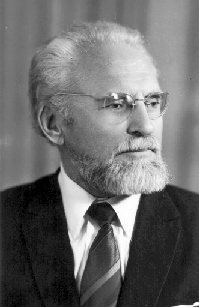

Many mass media declared Grisha Perelman the 2006 Scientist of the Year in recognition of the Fields Medal award for his proof of the Poincare conjecture. Perelman is the last postgraduate student supervised by Alexandr Danilovich Alexandrov (1912–1999) the anniversary of whose birth we celebrate this year.
Many years ago some visiting professor persuaded Alexandrov in my presence to make a demarche at the public maintenance of a mediocre geometric thesis. The defendant was a Jew, and the final argument of the Muscovite professor was xenophobia. He pointed to the picturesque and rather gloomy figure of a complete stranger to the event at the end of a corridor and began blaming us in the sense that if we disagreed to his proposal then “everyone would be like that down here.” By the vicissitudes of fate, the lad in the corner was Perelman, a postgraduate of Alexandrov, a student of Victor Zalgaller and Yuri Bugaro both students of Alexandrov.
The love and hatred to Alexandrov stemmed from the same sources. His reviews and opinions were welcome and appreciated, but his approaches and areas of research were silenced if not scorned. He was accused of zionism, but many bet and counted upon his antisemitism. His communistic beliefs were blasphemed obscenely, but he was humbly requested to write a letter or two to the Central Committee of the Communist Party of the USSR or The Communist magazine. His philosophical essays were spit upon furiously, but the same despisers required that their students used Alexandrov’s popular writings at the final examinations in philosophy which were obligatory for admittance to the public maintenance of theses. The professorship of St. Petersburg is full of raptures about the palace, fountain, and park ensemble of Peterhof, but most of Alexandrov’s colleagues will never forgive the sage decision of Rector Alexandrov who suggested to build a new university campus in Peterhof. During the years of Gorbi’s “perestroika” Alexandrov was accused in confessing lysenkoism but decorated with the Order of the Red Banner of Labor for his efforts in safeguarding and propelling genetics and selection in the USSR. So were the scales of Alexandrov’s personality.
Alexandrov often remarked that a man is what he does. Alexandrov did the business of geometry. It is more appropriate to speak about geometry as his most adorable part of the universal science, mathematics. Mac Lane, a cofather of category theory, had coined the term “working mathematician” which is rather close to the routine “workman” or even “toiler.” Mac Lane wrote not only about work in mathematics but also about criteria of excellence in mathematics. Excellent mathematics by Mac Lane should be inevitable, illuminating, deep, relevant, responsive, and timely. Excellent mathematics is exercised by excellent mathematicians, mathematicians par excellence. Such was Alexandrov.
Alexandrov contributed to mathematics under the slogan: “Retreat to Euclid.” He remarked that “the pathos of contemporary mathematics is the return to Ancient Greece.” Minkowski revolutionized the theory of numbers with the aid of the synthetic geometry of convex figures. The ideas and techniques of the geometry of numbers comprised the fundamentals of functional analysis which was created by Banach. The pioneering studies of Alexandrov continued the efforts of Minkowski and enriched geometry with the methods of measure theory and functional analysis. Alexandrov accomplished the turnround to the ancient synthetic geometry in a much deeper and subtler sense than it is generally acknowledged today. Geometry in the large reduces in no way to overcoming the local restrictions of differential geometry which bases upon the infinitesimal methods and ideas of Newton, Leibniz, and Gauss.
The works of Alexandrov made tremendous progress in the theory of mixed volumes of convex figures. He proved some fundamental theorems on convex polyhedra that are celebrated alongside the theorems of Euler and Minkowski. While discovering a solution of the Weyl problem, Alexandrov suggested a new synthetic method for proving the theorems of existence. The results of this research ranked the name of Alexandrov alongside the names of Euclid and Cauchy.
Another outstanding contribution of Alexandrov to science is the creation of the intrinsic geometry of irregular surfaces. He suggested his amazingly visual and powerful method of cutting and gluing. This method enabled him to solve many extremal problems of the theory of manifolds of bounded curvature.
Alexandrov developed the theory of metric spaces with one-sided constraints on curvature. This gave rise to the class of metric spaces generalizing the Riemann spaces in the sense that these spaces are furnished with some curvature, the basic concept of Riemannian geometry. The research of Alexandrov into the theory of manifolds with bounded curvature prolongates and continues the traditions of Gauss, Lobachevskii, Poincare, and Cartan.
Alexandrov enriched the methods of differential geometry by the tools of functional analysis and measure theory, driving mathematics to its universal status of the epoch of Euclid. The mathematics of the ancients was geometry (there were no other instances of mathematics at all). Synthesizing geometry with the remaining areas of the today’s mathematics, Alexandrov climbed to the antique ideal of the universal science incarnated in mathematics. Return to the synthetic methods of mathesis universalis was inevitable and unavoidable as illustrated in geometry with the beautiful results of the disciples and followers of Alexandrov like Gromov, Perelman, Pogorelov, and Reshetnyak.
The first and foremost Russian geometer of the nineteenth century was Nikolai Ivanovich Lobachevskii.
Alexandr Danilovich Alexandrov became the first and foremost Russian geometer of the twentieth century.
S. Kutateladze
January 7, 2007
| English Page | Russian Page |